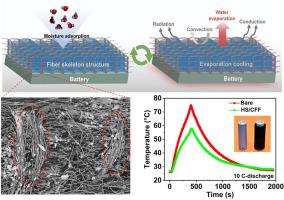Highly hygroscopic needle-punched carbon fiber felt with high evaporative cooling efficiency and fire resistance for safe operation of ultrahigh-rate lithium-ion batteries
IF 11.2
1区 材料科学
Q1 MATERIALS SCIENCE, MULTIDISCIPLINARY
引用次数: 0
Abstract
The effective thermal management of lithium-ion batteries is the key to ensuring their fast charging-discharging, safe and efficient operation. Herein, inspired by transpiration-driven water transport in plants, we report a highly hygroscopic needle-punched carbon fiber felt (HS/CFF) with high evaporative cooling efficiency and fire resistance for the safe operation of lithium-ion batteries working at ultrahigh-rate conditions. The three-dimensional fiber skeleton structure constructed by needle punching in the carbon fiber felt enables effective water transport and storage in HS/CFF, without any water leakage. At an ultra-high discharge rate of 10 C, HS/CFF can reduce the maximum temperature of commercial lithium-ion batteries by 18 °C, and can keep the battery temperature below 60 °C. During 500 cycles of charge-discharge, HS/CFF maintains stable evaporative heat dissipation performance, which helps to improve the safety of lithium-ion batteries and extend their service life. Moreover, HS/CFF remains non-combustible even under exposure to a flame (600-700 °C) for 10 min, and the HS/CFF can be reused after the burning test, with the original excellent heat dissipation effect unchanged. This flexible, fire-resistant cooling material offers a promising avenue for low-energy intelligent thermal management of lithium-ion batteries and other heat-generating electronic devices.

高吸湿性针刺碳纤维毡具有高蒸发冷却效率和防火性能,可确保超高速锂离子电池的安全运行
锂离子电池的有效热管理是确保其快速充放电、安全高效运行的关键。在此,我们受植物蒸腾作用驱动的水分传输的启发,报告了一种具有高蒸发冷却效率和防火性能的高吸湿性针刺碳纤维毡(HS/CFF),用于锂离子电池在超高速条件下的安全运行。通过针刺碳纤维毡构建的三维纤维骨架结构可实现 HS/CFF 的有效水分传输和存储,且不会出现任何漏水现象。在 10 C 的超高放电率条件下,HS/CFF 可将商用锂离子电池的最高温度降低 18 °C,并可将电池温度控制在 60 °C 以下。在 500 次充放电循环过程中,HS/CFF 仍能保持稳定的蒸发散热性能,有助于提高锂离子电池的安全性并延长其使用寿命。此外,HS/CFF 即使暴露在火焰(600-700 °C)中 10 分钟也不会燃烧,并且在燃烧测试后可重复使用,原有的出色散热效果保持不变。这种柔性阻燃冷却材料为锂离子电池和其他发热电子设备的低能耗智能热管理提供了一条前景广阔的途径。
本文章由计算机程序翻译,如有差异,请以英文原文为准。
求助全文
约1分钟内获得全文
求助全文
来源期刊

Journal of Materials Science & Technology
工程技术-材料科学:综合
CiteScore
20.00
自引率
11.00%
发文量
995
审稿时长
13 days
期刊介绍:
Journal of Materials Science & Technology strives to promote global collaboration in the field of materials science and technology. It primarily publishes original research papers, invited review articles, letters, research notes, and summaries of scientific achievements. The journal covers a wide range of materials science and technology topics, including metallic materials, inorganic nonmetallic materials, and composite materials.
 求助内容:
求助内容: 应助结果提醒方式:
应助结果提醒方式:


